



The M37 (Also known as M1937) helmet is a military steel combat helmet used by Swedish armed forces. Replacing the M1926 helmet, the M1937 would be modernized in 1965 and see use into the 1990s with its replacement by the M1990 Kevlar helmet.




The M37 (Also known as M1937) helmet is a military steel combat helmet used by Swedish armed forces. Replacing the M1926 helmet, the M1937 would be modernized in 1965 and see use into the 1990s with its replacement by the M1990 Kevlar helmet.
The helmet features a shell design distinct from its predecessors, being more hemispherical in its appearance with a simplified shape. The M1937 shared the same liner as its former designs, featuring a three pad liner attached directly to the shell like the M1926, along with a simple buckle chinstrap. Sweden would provide Finland with this model helmet as aid during their conflict with the Soviet Union (known as the Winter War). Finland produced a copy of the M37 known as the M40 at the Wartsila Oy and Kone-ja Silta plants. The main difference between the Finnish production helmets being the M40 was made of slightly heavier materials for the shell and painted in a green color as opposed to the Swedish grey. In 1965, most helmets received a new liner, being attached to the top of the shell by only a single rivet made up of a canvas webbing and sheet metal attached to a leather sweatband. The model with the modernized liner being commonly known as the M37/65. [1] The Finnish M40s also receiving a modernized liner nearly identical to the M37/65 around the same time. Commonly used with the helmet was a plain color camouflage net cover in dark green named the M1960. [2] The cover has a simple drawstring design where the chin straps would loop through the cover to keep it in place, and a drawstring on top of the cover to size it to the shell. An additional component of the cover being fold down flaps to cover additional areas of the head as well as a sun brim.

The Brodie helmet is a steel combat helmet designed and patented in London in 1915 by John Leopold Brodie. A modified form of it became the Helmet, Steel, Mark I in Britain and the M1917 Helmet in the U.S. Colloquially, it was called the shrapnel helmet, battle bowler, Tommy helmet, tin hat, and in the United States the doughboy helmet. It was also known as the dishpan hat, tin pan hat, washbasin, battle bowler, and Kelly helmet. The German Army called it the Salatschüssel. The term Brodie is often misused. It is correctly applied only to the original 1915 Brodie's Steel Helmet, War Office Pattern.

The Stahlhelm is a specific type of German military headgear made of steel, which is primarily intended to provide protection against fragments of grenades. The term Stahlhelm refers both to a generic steel helmet, and more specifically to the distinctive German military design.
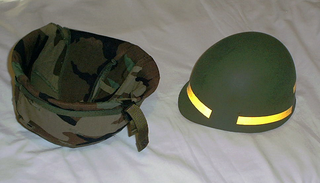
The M1 helmet is a combat helmet that was used by the United States military from World War II until 1985, when it was succeeded by the PASGT helmet. For over forty years, the M1 was standard issue for the U.S. military. The M1 helmet has become an icon of the American military, with its design inspiring other militaries around the world.
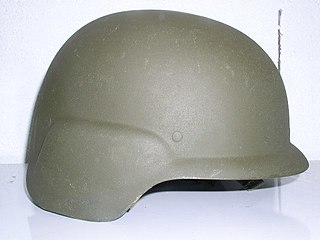
The SPECTRA helmet or CGF Gallet Combat Helmet is the PASGT-style ballistic helmet in use with the French military, and the armies of several other countries. Built by CGF Gallet, it weighs 1.4 kg (3.1 lb), is available in three sizes, and is made from ultra-high-molecular-weight polyethylene Spectra fibers, produced under license from Honeywell.

The hełm wz. 31 was the basic combat helmet of the Polish Army before the outbreak of World War II and during the Invasion of Poland. The helmet became the basic type of combat headgear for Polish military formations in 1930s and during the early stages of World War II. It was also exported to Persia, Albania and Republican Spain. By September 1939 approximately 320,000 copies were delivered to the Polish Army.
Over the course of World War II the Soviet Union employed three main helmet designs; the SSh-36, the SSh-39, and the SSh-40, each being designated with the year in which they were introduced. Standard practice was to stamp the size, location, and year of manufacturing on the interior of the helmet.
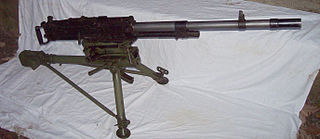
The Mitragliatrice Breda calibro 8 modello 37 was an Italian Medium machine gun produced by Breda and adopted in 1937 by the Royal Italian Army. It was the standard machine gun for the Royal Italian Army during World War II, and continued to be used by the Italian Army after the conflict. The Breda 37 was meant as company/battalion support as compared to the more troublesome Breda 30 meant for squad/platoon support, and proved far more effective in combat, though possessing some of the same problematic features of the Breda 30.
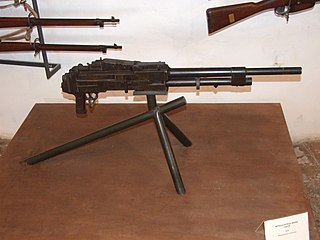
The Mitragliatrice Breda calibro 8 modello 38 per carri armati was an Italian tank-pattern machine gun used in the Second World War on the Fiat L6/40, the Fiat M11/39 and the Fiat M13/40. It was also adapted as infantry machine gun. The M38 is based upon the Breda M37. The Breda 38 received the German identification code Kampfwagen-Maschinengewehr 350(i).

The Type 66 is a Combat helmet that was used by the Japanese Self-Defense Force after the adoption of the M1 helmet, supplied by the United States when the former National Police Reserve was established. It has not been exported out of Japan since it was adopted by the JSDF.

The M1926 helmet is a military steel combat helmet that was used by Swedish Armed Forces.

The M32 helmet also known as M32/34 is a military steel combat helmet used by Czechoslovakia from its adoption in 1932 to its annexation by Nazi Germany in 1939. The helmet also being used by the Slovak Republic and Finland among other countries that the helmet would be worn by.

The M1918 helmet is a steel military combat helmet used by Switzerland from its introduction in 1918 to its replacement by the M1971. In 1943 improvements would be made to the design to which it would be called the M1918/40.

The M1971 helmet is a military steel combat helmet used by Switzerland from its formal introduction in 1971 until its gradual replacement by the Schuberth B826.

The M1942 helmet is a military steel combat helmet used by Spain from its adoption in 1942 to its replacement by a Spanish M1 copy in the 1980s.

The M1926 Helmet, is a steel combat helmet used by Spain from its adoption in 1930 until its replacement by the M42 in 1942. The helmet would be a common sight along with many other helmets between both sides in the Spanish Civil War.
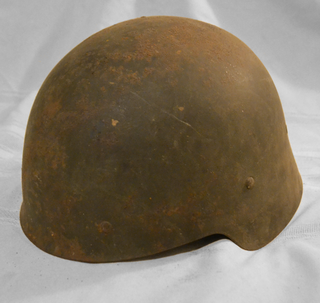
The M1921 Helmet, is a steel combat helmet developed alongside the M1926 helmet in 1926 for use by the Spanish Army. The model never being formally adopted by the army in favor of the M1926. The exact reasoning for the designation "M1921" is not known as it was developed later.

The M70 is a steel combat helmet used by Hungary, a license made copy of the Soviet SSh-40 and further development of the previous model M50 helmet.

The M1934 helmet is a steel combat helmet used by various factions in the Spanish Civil War. Meant not for use by the Army, but instead by security forces such as police, the helmet was of similar shape to the Model 1926 helmet in use by the army. The helmet would mainly see use by the Nationalists in the conflict.
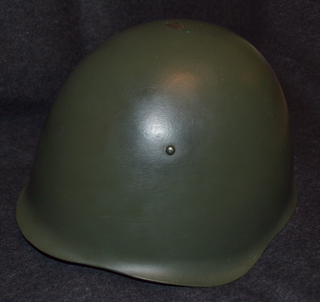
The Wz50 also known as M50 is a steel combat helmet used by Poland from its introduction in 1950 to its replacement by the Wz67 in 1967. The helmet would be widely exported to a number of Arab countries for its low price.

The M34 is a steel combat helmet used by the Netherlands from its introduction in 1934 replacing the previous M23/27, to the invasion by Nazi Germany in 1940. From which it was replaced by the M53 helmet, a local copy of the American M1 helmet. A tropical variant of this helmet was produced for use by the Dutch East India Army in present-day Indonesia known as the KNIL model.
| Wikimedia Commons has media related to Hjälm 37 . |